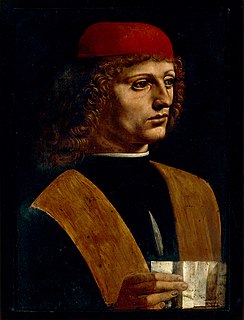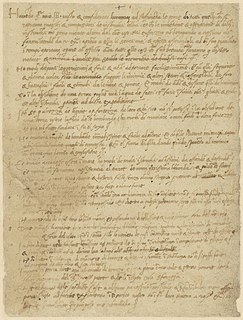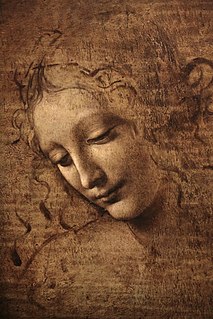
Leonardo di ser Piero da Vinci was an Italian polymath of the High Renaissance who was active as a painter, draughtsman, engineer, scientist, theorist, sculptor, and architect. While his fame initially rested on his achievements as a painter, he also became known for his notebooks, in which he made drawings and notes on a variety of subjects, including anatomy, astronomy, botany, cartography, painting, and paleontology. Leonardo is widely regarded to have been a genius who epitomized the Renaissance humanist ideal, and his collective works comprise a contribution to later generations of artists matched only by that of his younger contemporary, Michelangelo.

The Last Supper is a mural painting by the Italian High Renaissance artist Leonardo da Vinci, dated to c. 1495–1498. The painting represents the scene of the Last Supper of Jesus with the Twelve Apostles, as it is told in the Gospel of John – specifically the moment after Jesus announces that one of his apostles will betray him. Its handling of space, mastery of perspective, treatment of motion and complex display of human emotion has made it one of the Western world's most recognizable paintings and among Leonardo's most celebrated works. Some commentators consider it pivotal in inaugurating the transition into what is now termed the High Renaissance.

Ludovico Maria Sforza, also known as Ludovico il Moro. "Arbiter of Italy", according to the expression used by Guicciardini, was an Italian Renaissance nobleman who ruled as Duke of Milan from 1494 to 1499.

The Vitruvian Man is a drawing by the Italian Renaissance artist and scientist Leonardo da Vinci, dated to c. 1490. Inspired by the writings by the ancient Roman architect Vitruvius, the drawing depicts a nude man in two superimposed positions with his arms and legs apart and inscribed in both a circle and square. Described by the art historian Carmen C. Bambach as "justly ranked among the all-time iconic images of Western civilization," the work is a unique synthesis of artistic and scientific ideals and often considered an archetypal representation of the High Renaissance.

Leonardo's robot, or Leonardo's mechanical knight, was a humanoid automaton designed and possibly constructed by Leonardo da Vinci around the year 1495.
Andrea Solari (1460–1524) was an Italian Renaissance painter of the Milanese school. He was initially named Andre del Gobbo, but more confusingly as Andrea del Bartolo a name shared with two other Italian painters, the 14th-century Siennese Andrea di Bartolo, and the 15th-century Florentine Andrea di Bartolo.

Francesco Melzi, or Francesco de Melzi (1491–1570), was an Italian painter born into a family of the Milanese nobility in Lombardy. He was one of Leonardo da Vinci’s pupils, and the literary executor of all da Vinci's papers, which he edited into a manuscript on painting later published as Tratatto della Pittura [Treatise on Painting] and the Codex Urbinas.

The Portrait of a Musician is an unfinished painting widely attributed to the Italian Renaissance artist Leonardo da Vinci, dated to c. 1483–1487. Produced while Leonardo was in Milan, the work is painted in oils, and perhaps tempera, on a small panel of walnut wood. It is his only known male portrait painting, and the identity of its sitter has been closely debated among scholars.

Saint John the Baptist is a High Renaissance oil painting on walnut wood by Leonardo da Vinci in the Louvre, Paris. Likely to have been completed between 1513 and 1516, it is believed to be his final painting. Its original size was 69 by 57 centimetres.

Leonardo da Vinci was an Italian Renaissance painter and polymath who achieved legendary fame and iconic status within his own lifetime. His renown primarily rests upon his brilliant achievements as a painter, the Mona Lisa and The Last Supper, being two of the most famous artworks ever created, but also upon his diverse skills as a scientist and inventor. He became so highly valued during his lifetime that the King of France bore him home like a trophy of war, supported him in his old age and, according to legend, cradled his head as he died.

Giovanni Antonio Boltraffio was an Italian painter of the High Renaissance from Lombardy, who worked in the studio of Leonardo da Vinci. Boltraffio and Bernardino Luini are the strongest artistic personalities to emerge from Leonardo's studio. According to Giorgio Vasari, he was of an aristocratic family and was born in Milan.

The Italian polymath Leonardo da Vinci (1452–1519) left thousands of pages of writings and drawings, but rarely made any references to his personal life. The resulting uncertainty, combined with mythologized anecdotes from his lifetime, has resulted in much speculation and interest in Leonardo's personal life. Particularly, his personal relationships, philosophy, religion, vegetarianism, left-handedness and appearance.

Leonardo da Vinci (1452–1519) was an Italian polymath, regarded as the epitome of the "Renaissance Man", displaying skills in numerous diverse areas of study. Whilst most famous for his paintings such as the Mona Lisa and the Last Supper, Leonardo is also renowned in the fields of civil engineering, chemistry, geology, geometry, hydrodynamics, mathematics, mechanical engineering, optics, physics, pyrotechnics, and zoology.

La Vita di Leonardo Da Vinci — in English, The Life of Leonardo da Vinci — is a 1971 Italian television miniseries dramatizing the life of the Italian Renaissance genius Leonardo da Vinci (1452–1519).

Gian Giacomo Caprotti da Oreno, better known as Salaì was an Italian artist and pupil of Leonardo da Vinci from 1490 to 1518. Salaì entered Leonardo's household at the age of ten. He created paintings under the name of Andrea Salaì. He was described as one of Leonardo's students and lifelong companion and servant and was the model for Leonardo's St. John the Baptist,Bacchus and Angelo incarnato.

La Scapigliata is an unfinished painting generally attributed to the Italian High Renaissance artist Leonardo da Vinci, and dated c. 1506–1508. Painted in oil, umber, and white lead pigments on a small poplar wood panel, its attribution remains controversial, with several experts attributing the work to a pupil of Leonardo. The painting has been admired for its captivating beauty, mysterious demeanor, and mastery of sfumato.

Salvator Mundi is a painting attributed in whole or in part to the Italian High Renaissance artist Leonardo da Vinci, dated to c. 1499–1510. Long thought to be a copy of a lost original veiled with overpainting, it was rediscovered, restored, and included in a major exhibition of Leonardo's work at the National Gallery, London, in 2011–2012. Christie's claimed just after selling the work that most leading scholars consider it to be an original work by Leonardo, but this attribution has been disputed by other specialists, some of whom posit that he only contributed certain elements.

The Leonardeschi were the large group of artists who worked in the studio of, or under the influence of, Leonardo da Vinci. They were artists of Italian Renaissance painting, although his influence extended to many countries within Europe.

Leonardo is a historical drama created by Frank Spotnitz and Steve Thompson. The series was produced by Italian Lux Vide in collaboration with Rai Fiction, Sony Pictures Entertainment, with Frank Spotnitz's Big Light Productions and Freddie Highmore's Alfresco Pictures in association with France Télévisions and RTVE.

Head of a Bear is a drawing study made by Leonardo da Vinci circa 1480. It is small in scale, measuring only 7 by 7 centimetres, and is rendered in silverpoint pencil. It is thought to be part of a study of animals that Leonardo made in this period. The artist may have drawn upon this study when painting the head of the animal in his Lady with an Ermine of 1489–1490. The drawing was owned by the British painter Sir Thomas Lawrence in the 18th century and by the art collector Norman Colville in the early 20th century. The American billionaire Thomas Kaplan purchased the drawing in 2008. It sold in 2021 for a total of £8.8 million, a record for a drawing by Leonardo.


















